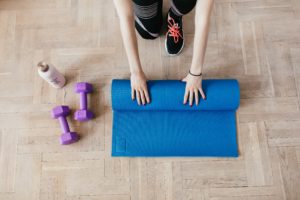3 Huge Fitness Mistakes We’ve All Made
Moving your body daily and working out is an important part of health. While on a fitness journey, exercise is crucial and improves cardiovascular health, and mental health, and boosts wellness. These huge fitness mistakes are very common but can set us back heavily.

Keep reading to find out what the most common huge fitness mistakes are, and what to do instead to increase overall health and wellness with ease. Plus, check out the quick tips to make fitness more accessible to everyone, from beginners to advanced individuals.
3 Huge Fitness Mistakes Everyone Has Made
Here are 3 huge fitness mistakes that everyone has made, and how to fix them easily. While everyone makes mistakes, doing these can lead to negative consequences such as injuries or lack of progress in your fitness journey. Finding out what the issues are and implementing simple solutions can mean the difference between a boost in health or a reduction in wellbeing.
1. Overdoing Cardio
When we first start a fitness journey, many of us will have a plan to lose weight. This can lead to us simplifying the equation of health and weight loss to calories in, calories out. We tend to eat less and work out a lot all at once. One of the main options people use is doing cardio, a lot of it.
While cardio is incredibly good for cardiovascular health, overdoing it is an issue. This can lead to injury, burnout, and even a reduction in metabolism. So, what should we do instead?
What to do instead:
Instead of intense cardio, focus on short cardio sessions like HIIT, and high-intensity interval training. This can burn a lot of calories in a fraction of the time, and can even have the benefit of increasing VO2 max. This measures how well your body utilizes oxygen during a workout. This type of cardio can be very beneficial and will not overwork the body in the same way hours of long cardio will. Plus, we want our goals to be more focused on health than body image.
While there’s nothing wrong with wanting to change how you look, it is important to focus on goals that don’t include body image. This is because focusing on changing ourselves can lead to mental health issues like body dysmorphia.
2. Avoiding Resistance Training
Along the same vein, when people are starting a fitness journey to lose weight, they tend to only focus on cardio and ignore weights altogether. This may be for a variety of reasons, whether it’s wanting to avoid looking bulky or a lack of mobility. Maybe you don’t have access to gym equipment, maybe you know little to nothing about what resistance training is, or maybe you think cardio is the best form of exercise.
What to do instead:
In reality, avoiding resistance training is very common but it could be detrimental to a fitness journey. Resistance training, especially certain movements, can help you go through life with more ease. Functional exercises boost strength in a way that will allow you to perform everyday tasks at a more optimal rate. This can include something like carrying your groceries in from the car, picking up your children, or walking your dog.
Well, some may think resistance training can only happen at the gym, but there are good workouts that you can do right from the comfort of your home. The point of resistance training is to boost strength and increase mobility in a way that allows your muscles to grow or maintain themselves. If you don’t use your muscles, you will lose them, and after age 30 we tend to lose muscle mass if we don’t train to prevent that loss.
Some form of resistance training can even be done with your body weight. This is called calisthenics, and there are ways to make calisthenic exercises easier or harder depending on your current level of ability. Check out this full-body workout that you could do from the comfort of your home, as well as this guide to what resistance training does for the muscles.
3. Warming Up Incorrectly
When starting a fitness journey, many people will either skip warming up altogether or warm up wrong. This is very common, as there is no one set way to warm up. While there are many perfectly acceptable ways, there are a couple of wrong ways, such as skipping the warm-up all together. Maybe you jump right into the exercise and assume you’ll warm up naturally.
What to do instead:
The best form of warming up is a series of dynamic stretches, holding the pose for a couple of seconds. This has two benefits. One, dynamic stretches help get the blood flowing through the body and will prepare you for movement that is to come. Plus, a dynamic warm-up can help improve flexibility which in turn improves range of motion and mobility. This can help prevent injury during a workout.
Another very effective way to warm up is to go through the motions of your workout first with just your body weight. For example, if in your workout, you are going to squat with a barbell, it may be beneficial for you to do some bodyweight squats with no added weight. This type of practice can help engage the muscles that are going to be used during your workout and prep them for harder heavier loads.
Quick Tips for a Good Fitness Journey
Here are some simple tips for you to do good on a fitness journey. They’re useful whether you are a beginner, intermediate, or advanced individual.
- Warm-up and cool down – you are always going to want to warm up the muscles before a workout to prepare them for activity. You also want to cool down, as stretching after a workout can help the muscles relax and relieve any pain or tension that’ll workout may have caused.
- Fuel up – one common mistake is not fueling up properly for a workout. You will want to eat enough protein, healthy fats, and healthy carbohydrates for you to perform well. You’ll also want to fuel up after a workout to allow the body to repair, reset, and thrive.
- Recover – recovery is essential for a workout. When you push your body, you are going to want to monitor how it feels afterward. A good recovery strategy includes eating well, stretching, massaging, and taking active rest days. Active rest days can help you recover faster by moving your body and working through any soreness with light activity such as a short walk or yoga.
- Sleep – when we sleep, vital repair activity happens throughout the body. This means that when we sleep well we can perform better and recover from a workout faster.
- Show Up – there will be days when you don’t feel like working out, and that’s okay. If you are sick and need rest, take a rest day. However, if it is a case of lacking motivation, show up to your workout and give about 80% effort or less. Maybe give 50% effort. The important thing is to show up and move your body.
The Takeaway
There are huge fitness mistakes that people make, especially when they are just starting out on a fitness journey. Luckily they could be easily fixed with small and easily implemented adjustments. Make sure you’re avoiding these common issues in order to avoid consequences like injury or burnout.
Remember that health comes from within. Eat nutrient-dense food, move your body, and care for your mental health. Daily habits are the building blocks for emotional, mental, and physical health. As shown above, take care of your gut health! Learn everything you need to know about gut microbiota today for free here.





